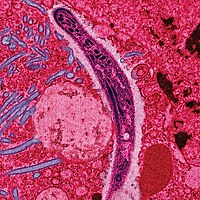
Photo from wikipedia
Bacterial culture (BC) and quantitative polymerase chain reaction (qPCR) are widely used as diagnostic tests for pathogens causing intra-mammary infections (IMI) and it is therefore important to evaluate their performance… Click to show full abstract
Bacterial culture (BC) and quantitative polymerase chain reaction (qPCR) are widely used as diagnostic tests for pathogens causing intra-mammary infections (IMI) and it is therefore important to evaluate their performance to optimize pathogen detection. However, with no reference standard, their sensitivity (Se) and specificity (Sp) are unknown. Furthermore, the Se and Sp can differ between quarter samples and composite samples, both of which can be used to test for IMI. Latent class analysis (LCA) offers a method for estimating the Se and Sp of two tests on the same population, but to our knowledge this has not yet been applied to qPCR and BC for the detection of Staph. aureus in both composite and aseptically collected quarter milk samples. This allows for a performance evaluation of not only the two diagnostic methods, but also the two different samples -both cow and quarter level. In this study, we used Bayesian LCA on a dataset from one sampling day at a Danish dairy herd to estimate the Se and Sp for detecting Staph. aureus at cow and quarter level. We used Ct cut-offs of 32 and 37 cycles for the qPCR. When using a cut-off of 37 cycles, the estimated Se and Sp for BC were 62.2% and 90.5% at cow level, and 90.7% and 93.5% at quarter level, respectively. Similarly, the estimated Se and Sp for qPCR at cow level were 82.7% and 84.1%, respectively, and 80.0% and 96.8% at quarter level. Sp was therefore higher for both BC and qPCR at quarter level. Se was also highest for BC at quarter level, but the opposite was true for qPCR. The same pattern was found using a Ct cut-off at 32 cycles, but with different estimates. The results show that qPCR with a Ct cut-off at 37 had a higher Se than BC for composite DHI samples and it is therefore more suitable as a routine screening test for Staph. aureus. However, BC on quarter samples gave the highest Se and Sp and should therefore be used for confirmatory testing.
Journal Title: Preventive veterinary medicine
Year Published: 2019
Link to full text (if available)
Share on Social Media: Sign Up to like & get
recommendations!